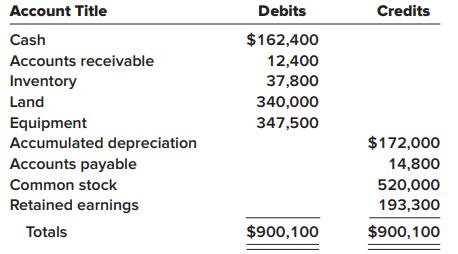On January 1, 2021, the general ledger of Parts Unlimited included the following account balances: a. Purchased
Question:
On January 1, 2021, the general ledger of Parts Unlimited included the following account balances:

a. Purchased inventory on account, $325,800.
b. Sold inventory on account, $567,200. The inventory cost $342,600.
c. Received cash from customers on account, $558,700.
d. Paid cash on account, $328,500. e. Paid cash for salaries, $94,700, and for utilities, $52,700.
In addition, Parts Unlimited had the following transactions during the year:
April 1 Purchased equipment for $95,000 using a note payable, due in 12 months plus 8% interest. The company also paid cash of $3,200 for freight and $3,800 for installation and testing of the equipment. The equipment has an estimated residual value of $10,000 and a ten-year service life.
June 30 Purchased a patent for $40,000 from a third-party marketing company related to the packaging of the company’s products. The patent has a 20-year useful life, after which it is expected to have no value.
October 1 Sold equipment for $30,200. The equipment cost $60,700 and had accumulated depreciation of $37,400 at the beginning of the year. Additional depreciation for 2021 up to the point of the sale is $8,500.
November 15 Several older pieces of equipment were improved by replacing major components at a cost of $54,100. These improvements are expected to enhance the equipment’s operating capabilities. [Record this transaction using Alternative 2—capitalization of new cost.]
Required:
1. Record each of the transactions listed above in the ‘General Journal’ tab (these are shown as items 1–11) assuming a perpetual inventory system. Review the ‘General Ledger’ and the ‘Trial Balance’ tabs to see the effect of the transactions on the account balances.
2. Record adjusting entries on December 31 in the ‘General Journal’ tab (these are shown as items 12–17): a. Depreciation on the equipment purchased on April 1, 2021, calculated using the straight-line method. b. Depreciation on the remaining equipment, $21,500. c. Amortization of the patent purchased on June 30, 2021, using the straight-line method. d. Accrued interest payable on the note payable. e. Equipment with an original cost of $65,400 had the following related information at the end of the year: accumulated depreciation of $40,300, expected cash flows of $15,700, and a fair value of $10,800. f. Accrued income taxes at the end of the year are $12,600.
3. Review the adjusted ‘Trial Balance’ as of December 31, 2021, in the ‘Trial Balance’ tab.
4. Prepare a multiple-step income statement for the period ended December 31, 2021, in the ‘Income Statement’ tab.
5. Prepare a classified balance sheet as of December 31, 2021, in the ‘Balance Sheet’ tab.
6. Record closing entries in the ‘General Journal’ tab.
7. Using the information from the requirements above, complete the ‘Analysis’ tab.
a. Calculate the fixed asset turnover ratio for the year, using the total amount of property, plant, and equipment (net of accumulated deprecation). If the industry average fixed asset turnover is 0.75, is the company more or less efficient at generating sales with its fixed assets than other companies in the same industry?
b. Suppose the equipment purchased on April 1, 2021, had been depreciated using the units of production method. At the time of purchase, expected output was 20,000 units, and actual production for 2021 was 2,000 units. Calculate the amount of depreciation expense that would have been recorded and determine the difference in net income and total assets for 2021 (ignoring tax effects).
c. The transaction on June 30, 2021, shows the company purchased a patent for $40,000 from a third-party marketing company. Suppose the company instead spent $40,000 to internally develop the new packaging technology, which it then patented. Calculate the difference in net income and total assets for 2021 (ignoring tax effects).
Balance SheetBalance sheet is a statement of the financial position of a business that list all the assets, liabilities, and owner’s equity and shareholder’s equity at a particular point of time. A balance sheet is also called as a “statement of financial...
Step by Step Answer:

Intermediate Accounting
ISBN: 978-1260481952
10th edition
Authors: J. David Spiceland, James Sepe, Mark Nelson, Wayne Thomas





